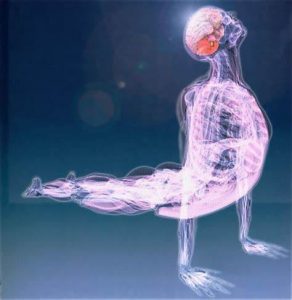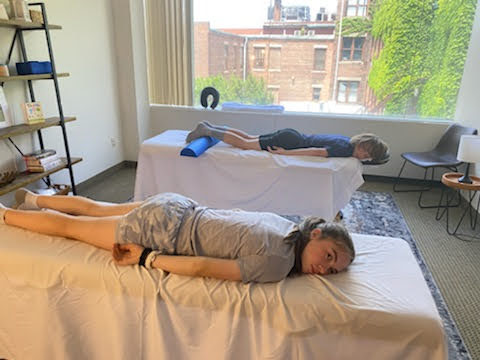What is Bowen Therapy?
How does Bowen work?
Bowen Therapy is a technique that aims to release tension and inflammation in the soft connective tissue. It is done using small, gentle moves that stimulate specific nerves, mechanoreceptors, that are intertwined within our fascial network.
A mechanoreceptor is a specialized sensory receptor that responds to mechanical pressure, translating physical forces into electrical signals that our nervous system can understand.
As the practitioner applies specific moves—gentle pushes, strategic holds, and subtle pressure—mechanoreceptors and other nerves within the fascia react by sending signals to the central nervous system and nearby cells.
Our goal is to signal the Central Nervous System (brain and spinal cord) to recognize and change dysfunctional patterns within the body that are unnecessarily creating pain and tension.
Its worthy to note that our brains are remarkably adaptable, thanks to a phenomenon called neuroplasticity. Essentially, neuroplasticity means that the brain can change and rewire itself in response to experiences and sensory input. Imagine it as a dynamic network of pathways that can be modified over time.
This means painful, stiff, tense bodies have a chance to heal permanently without intense treatments. In fact you may feel relaxation during a session like nothing you have ever experienced.

The Great Connector: Fascia
Fascia, often overlooked but crucial, wraps around our muscles, organs, and blood vessels like a protective casing. It’s the body’s silent architect, providing strength and structure. But here’s the intriguing part: recent studies reveal that fascia, especially the layers close to the surface, houses the second-highest number of mechanoreceptors after the skin. Together they play a vital role in our perception of touch, movement, and proprioception (awareness of body position)…
When fascia glides smoothly, mechanoreceptors thrive. They stretch, adapt, and send signals to the nervous system. But when fascia becomes restricted—unable to glide or stretch—mechanoreceptors and other nerves within the fascia suffer. If not managed correctly – tension, pain, stiffness, and loss of mobility may become the new “normal”. So if someone tells you “its just part of getting older” Don’t believe it. Regenerating healthy fascia, promoting healthy pathways for your nerves, and utilizing the principle of neuroplasticity should give even those suffering with chronic pain a more positive outlook.
By decreasing tissue tension, increasing circulation and lymphatic flow this not only helps significantly with muscle, fascia, ligament, and tendon conditions, but it also helps with stress management and all organ systems of the body:
- Joints
- Major Organs
- Musculoskeletal system
- Circulatory system
- Nervous System
- Proprioception (muscle memory)
- Interoception (balance)
- Fascial Rehydration
- Lymphatic System

The “Less is Best” Principle
This is most important, yet hard to understand in a world where “no pain, no gain” is often the normal expectation.
Lets go back to the mechanoreceptors. There is another type of receptor called a nociceptor. These too are embedded within the fascia and surrounding tissues. Nociceptors are like the body’s pain alarm system. They detect potentially harmful or damaging stimuli. They also can respond to touch, although usually at a much more intense level. Now if someone has been in pain for a long time or the pain is very severe, the likelihood of overstimulating an already active group of nociceptors is very high. This could be why flare ups happen after rigorous bodywork, especially for those in chronic pain or those who have very sensitive nervous systems.
In short, we don’t want to overload the Central Nervous System with too much stimulation. Unnecessary work will just delay and dilute the response traveling from the brain and the body, making the session less effective and possible more painful for a bit before it starts to get better.
It is the practitioner’s greatest skill to know the least amount of work needed to bring on a permanent healing response.

Why The Wait?
We take frequent breaks between sets of moves in Bowen and give the client time alone to rest. The breaks range from 2 minutes to 10 minutes, depending on what was done and how the client is feeling.
The waits allow the body time to process the cues we give it with the series of moves on the body. We then re-assess to see if more work is needed and where it should be done.
The waits are just as important as the moves themselves. We spoke earlier about how unnecessary moves delay and dilute the response from the nervous system, making the session less effective. Too many moves without waits can have a similar effect for the same reason, overloading the nervous system.
The 3 W’s.
Water – The Fascial network is made up mostly of water and as it releases it will need more water to rehydrate its cells and move smoothly causing less stiffness in the body. If water is not readily available, then the Fascia will not be able return to its healthy state, as is true with other deficiencies of nutritional supplements. It’s always best to have a conversation with your doctor for more advise on this topic.
Walking – Following the session you will be told to walk multiple times a day. Walking helps integrate the shifts that have taken place during the session. Sitting for long periods lessens blood flow to the lower body and slows any rebalancing taking place especially the week following the session. The more walks that are taken during the first few days the better.
Waiting – The brain has a blueprint of the way the body is supposed to be as it once was…long ago. The process of getting back to a pain free, functional state often takes a little time and patience to give the body a chance to activate its innate ability to heal. Following a Bowen session, the body usually needs 7 to 10 days for this process to begin. Goal setting and assessments are also done regularly to measure the progress. Oftentimes the client forgets the pain they originally first came in with because the improvement happened so naturally over a progression of a month that they didn’t notice it, until questioned.
Don’t be Nervous.
Most people start to feel like they are melting onto the table during a session. This is because Bowen settles the nervous system. It brings it out of the sympathetic state (fight or flight) and back into the parasympathetic state (rest and digest).
This is important to note. Intense, constant stress, good or bad, alters our nervous system and stunts any healthy, permanent, healing response.
Bowen helps get the body and mind back into a safe state so the healing process will succeed.
How does Bowen work?
Bowen Therapy is a technique that aims to release tension and inflammation in the soft connective tissue. It is done using small, gentle moves that stimulate specific nerves, mechanoreceptors, that are intertwined within our fascial network.
A mechanoreceptor is a specialized sensory receptor that responds to mechanical pressure, translating physical forces into electrical signals that our nervous system can understand.
As the practitioner applies specific moves—gentle pushes, strategic holds, and subtle pressure—mechanoreceptors and other nerves within the fascia react by sending signals to the central nervous system and nearby cells.
Our goal is to signal the Central Nervous System (brain and spinal cord) to recognize and change dysfunctional patterns within the body that are unnecessarily creating pain and tension.
Its worthy to note that our brains are remarkably adaptable, thanks to a phenomenon called neuroplasticity. Essentially, neuroplasticity means that the brain can change and rewire itself in response to experiences and sensory input. Imagine it as a dynamic network of pathways that can be modified over time.
This means painful, stiff, tense bodies have a chance to heal permanently without intense treatments. In fact you may feel relaxation during a session like nothing you have ever experienced.

The Great Connector: Fascia
Fascia, often overlooked but crucial, wraps around our muscles, organs, and blood vessels like a protective casing. It’s the body’s silent architect, providing strength and structure. But here’s the intriguing part: recent studies reveal that fascia, especially the layers close to the surface, houses the second-highest number of mechanoreceptors after the skin. Together they play a vital role in our perception of touch, movement, and proprioception (awareness of body position)…
When fascia glides smoothly, mechanoreceptors thrive. They stretch, adapt, and send signals to the nervous system. But when fascia becomes restricted—unable to glide or stretch—mechanoreceptors and other nerves within the fascia suffer. If not managed correctly – tension, pain, stiffness, and loss of mobility may become the new “normal”. So if someone tells you “its just part of getting older” Don’t believe it. Regenerating healthy fascia, promoting healthy pathways for your nerves, and utilizing the principle of neuroplasticity should give even those suffering with chronic pain a more positive outlook.
By decreasing tissue tension, increasing circulation and lymphatic flow this not only helps significantly with muscle, fascia, ligament, and tendon conditions, but it also helps with stress management and all organ systems of the body:
- Joints
- Major Organs
- Musculoskeletal system
- Circulatory system
- Nervous System
- Proprioception (muscle memory)
- Interoception (balance)
- Fascial Rehydration
- Lymphatic System

The “Less is Best” Principle
This is most important, yet hard to understand in a world where “no pain, no gain” is often the normal expectation.
Lets go back to the mechanoreceptors. There is another type of receptor called a nociceptor. These too are embedded within the fascia and surrounding tissues. Nociceptors are like the body’s pain alarm system. They detect potentially harmful or damaging stimuli. They also can respond to touch, although usually at a much more intense level. Now if someone has been in pain for a long time or the pain is very severe, the likelihood of overstimulating an already active group of nociceptors is very high. This could be why flare ups happen after rigorous bodywork, especially for those in chronic pain or those who have very sensitive nervous systems.
In short, we don’t want to overload the Central Nervous System with too much stimulation. Unnecessary work will just delay and dilute the response traveling from the brain and the body, making the session less effective and possible more painful for a bit before it starts to get better.
It is the practitioner’s greatest skill to know the least amount of work needed to bring on a permanent healing response.

Why The Wait?
We take frequent breaks between sets of moves in Bowen and give the client time alone to rest. The breaks range from 2 minutes to 10 minutes, depending on what was done and how the client is feeling.
The waits allow the body time to process the cues we give it with the series of moves on the body. We then re-assess to see if more work is needed and where it should be done.
The waits are just as important as the moves themselves. We spoke earlier about how unnecessary moves delay and dilute the response from the nervous system, making the session less effective. Too many moves without waits can have a similar effect for the same reason, overloading the nervous system.
The 3 W’s.
Water – The Fascial network is made up mostly of water and as it releases it will need more water to rehydrate its cells and move smoothly causing less stiffness in the body. If water is not readily available, then the Fascia will not be able return to its healthy state, as is true with other deficiencies of nutritional supplements. It’s always best to have a conversation with your doctor for more advise on this topic.
Walking – Following the session you will be told to walk multiple times a day. Walking helps integrate the shifts that have taken place during the session. Sitting for long periods lessens blood flow to the lower body and slows any rebalancing taking place especially the week following the session. The more walks that are taken during the first few days the better.
Waiting – The brain has a blueprint of the way the body is supposed to be as it once was…long ago. The process of getting back to a pain free, functional state often takes a little time and patience to give the body a chance to activate its innate ability to heal. Following a Bowen session, the body usually needs 7 to 10 days for this process to begin. Goal setting and assessments are also done regularly to measure the progress. Oftentimes the client forgets the pain they originally first came in with because the improvement happened so naturally over a progression of a month that they didn’t notice it, until questioned.
Don’t be Nervous.
Most people start to feel like they are melting onto the table during a session. This is because Bowen settles the nervous system. It brings it out of the sympathetic state (fight or flight) and back into the parasympathetic state (rest and digest).
This is important to note. Intense, constant stress, good or bad, alters our nervous system and stunts any healthy, permanent, healing response.
Bowen helps get the body and mind back into a safe state so the healing process will succeed.
